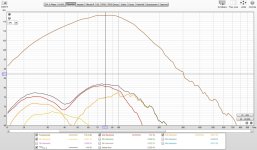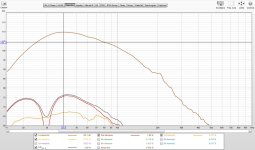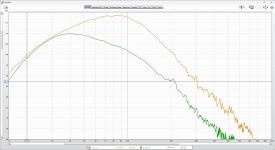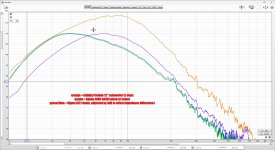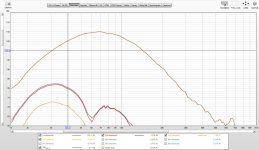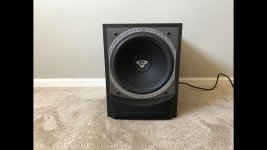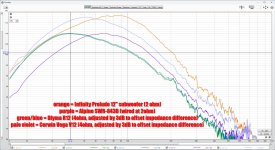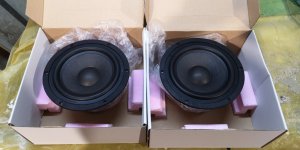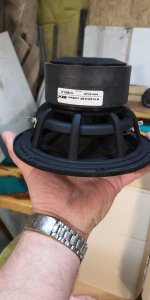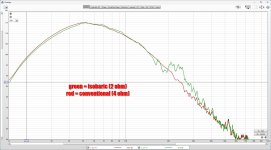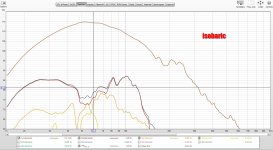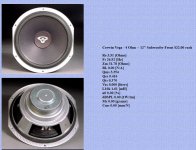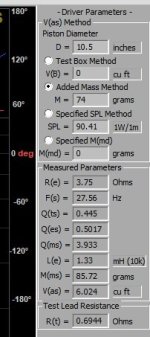Here's a few driver distortion measurements I made today
These aren't terribly scientific, but if they help someone out, cool! I just set my amp to -3dB and measured each driver at the same amplifier level, which isn't necessarily the same SPL level because the impedance of these drivers is all over the map
I used a 15Hz highpass and a 120Hz lowpass, both LR4
I used no baffle; this is just the raw driver
First one up is a measurement of a twelve inch Infinity woofer from the Infinity Prelude speaker. These are readily found on Craigslist for a few hundred bucks. I trashed mine (all of the mids and midbasses had surrounds that were trashed) but was pleasantly surprised by how capable the subwoofers are, despite looking fairly pedestrian
These aren't terribly scientific, but if they help someone out, cool! I just set my amp to -3dB and measured each driver at the same amplifier level, which isn't necessarily the same SPL level because the impedance of these drivers is all over the map
I used a 15Hz highpass and a 120Hz lowpass, both LR4
I used no baffle; this is just the raw driver
First one up is a measurement of a twelve inch Infinity woofer from the Infinity Prelude speaker. These are readily found on Craigslist for a few hundred bucks. I trashed mine (all of the mids and midbasses had surrounds that were trashed) but was pleasantly surprised by how capable the subwoofers are, despite looking fairly pedestrian
Attachments
Here's a DIYMA R12. This was a super affordable twelve inch woofer made by npdang over at DIY Mobile Audio almost twenty years ago.
Funny story:
I nearly threw these away.
Basically, the sensitivity on these is so low, I thought there was something wrong with them. I've had them in my garage for ages, and even had a few people interested in buying them, but was reluctant to do so because I thought they might be defective.
Whenever I played them full range and gave them a lot of power, they sounded pretty rough. One of the reasons I went to the trouble of measuring the distortion on some of my drivers today, was that I was trying to figure out if these are broken or not.
It looks like they work perfectly fine, they're just so low in sensitivity, if you play them full range and crank the volume, the 2nd and 3rd harmonic distortion will be more audible than the fundamental.
This is something that's vexxed me about low distortion subs, in general: you have to get accustomed to the fact that a sub that's really low distortion in a properly built enclosure will be FELT and not HEARD, and if you're not careful with the low pass you could wind up in a situation where most of what you're hearing is 2nd and 3rd harmonic, particularly if you don't listen at really high volumes.
The overlay shows the Infinity vs the DIYMA, note the Infinity is 10dB more sensitive above 100Hz. VAS on the DIYMA is something ridiculous, it works in a box of around half a cubic foot and the woofer weighs a TON because they had to use a ton of motor force to drive the VAS down. I had the Diymas in a 15Hz tapped horn back in the day and it nearly killed me moving the subwoofer. Thing was like a refrigerator:
https://www.diyaudio.com/community/threads/night-of-the-living-bassheads.168737/
Funny story:
I nearly threw these away.
Basically, the sensitivity on these is so low, I thought there was something wrong with them. I've had them in my garage for ages, and even had a few people interested in buying them, but was reluctant to do so because I thought they might be defective.
Whenever I played them full range and gave them a lot of power, they sounded pretty rough. One of the reasons I went to the trouble of measuring the distortion on some of my drivers today, was that I was trying to figure out if these are broken or not.
It looks like they work perfectly fine, they're just so low in sensitivity, if you play them full range and crank the volume, the 2nd and 3rd harmonic distortion will be more audible than the fundamental.
This is something that's vexxed me about low distortion subs, in general: you have to get accustomed to the fact that a sub that's really low distortion in a properly built enclosure will be FELT and not HEARD, and if you're not careful with the low pass you could wind up in a situation where most of what you're hearing is 2nd and 3rd harmonic, particularly if you don't listen at really high volumes.
The overlay shows the Infinity vs the DIYMA, note the Infinity is 10dB more sensitive above 100Hz. VAS on the DIYMA is something ridiculous, it works in a box of around half a cubic foot and the woofer weighs a TON because they had to use a ton of motor force to drive the VAS down. I had the Diymas in a 15Hz tapped horn back in the day and it nearly killed me moving the subwoofer. Thing was like a refrigerator:
https://www.diyaudio.com/community/threads/night-of-the-living-bassheads.168737/
Attachments
I measured my 2nd of two Diyma R12s, and the difference is about one decibel, so not going to bother posting the data
Good to see the quality control is consistent
Good to see the quality control is consistent
Here's an Alpine SRW-843D
I'm a big fan of the Alpine subs of this era; Alpine was basically offering subs with split gaps and shorting rings and underhung motors at prices that weren't much higher than the cheap Skar Audio stuff that's so ubiquitous on Amazon
Naturally, 90% of the car audio buyers couldn't care less about low distortion, and Alpine wound up getting gobbled up in some kind of weird merger:
https://www.reuters.com/article/alps-alpine-ma-oasis-idUSL3N2101IA
As far as the measurements go, a few thoughts:
1) I think the high distortion is deceptive here. When running the sweep, I can hear something buzzing, but I think it may be the frame of the sub itself. So two bucks worth of mortite could go a long way here. The Alpine weighs about 1/4 as much as the Diyma
2) We can see in the measurement that there's only so much bass you can squeeze out of an eight. The Alpine response looks a lot like the Infinity response, but about 8dB lower. The Alpine's VAS is just twelve liters: https://www.alpine.co.uk/fileadmin/...car_audio_manuals/SWR-823D/OM_SWR-823D_EN.pdf
The designer of the Diyma R12 told me that it took some inspiration from the Peerless XXLS subs. Due to this, it's worth comparing the BL^2/RE of the two. The BL^2/RE for the Peerless XXLS is 44.77 and for the Alpine it's 31.88
Assuming the R12 specs are similar (I still need to measure that), the R12 is definitely a better value. They were selling for around $100 when released. XXLS costs $216: https://www.digikey.com/en/products/detail/peerless-by-tymphany/XXLS-P835017/6557551
Which is actually a really good price for that kind of performance, all things considered
I'm a big fan of the Alpine subs of this era; Alpine was basically offering subs with split gaps and shorting rings and underhung motors at prices that weren't much higher than the cheap Skar Audio stuff that's so ubiquitous on Amazon
Naturally, 90% of the car audio buyers couldn't care less about low distortion, and Alpine wound up getting gobbled up in some kind of weird merger:
https://www.reuters.com/article/alps-alpine-ma-oasis-idUSL3N2101IA
As far as the measurements go, a few thoughts:
1) I think the high distortion is deceptive here. When running the sweep, I can hear something buzzing, but I think it may be the frame of the sub itself. So two bucks worth of mortite could go a long way here. The Alpine weighs about 1/4 as much as the Diyma
2) We can see in the measurement that there's only so much bass you can squeeze out of an eight. The Alpine response looks a lot like the Infinity response, but about 8dB lower. The Alpine's VAS is just twelve liters: https://www.alpine.co.uk/fileadmin/...car_audio_manuals/SWR-823D/OM_SWR-823D_EN.pdf
The designer of the Diyma R12 told me that it took some inspiration from the Peerless XXLS subs. Due to this, it's worth comparing the BL^2/RE of the two. The BL^2/RE for the Peerless XXLS is 44.77 and for the Alpine it's 31.88
Assuming the R12 specs are similar (I still need to measure that), the R12 is definitely a better value. They were selling for around $100 when released. XXLS costs $216: https://www.digikey.com/en/products/detail/peerless-by-tymphany/XXLS-P835017/6557551
Which is actually a really good price for that kind of performance, all things considered
Attachments
Here's one that looks really terrible at first glance. Cerwin Vega V 12S.
Apex Jr was blowing these out for a few years; IIRC I paid less than $100 for four!
The frame is stamped steel, there's no pole vent, voice coil is tiny, magnet is tiny, it just looks cheap cheap cheap
but...
1) it's pretty darn sensitive. Yes, I know sensitivity is nearly irrelevant for subwoofers, but if I had to pick between the $200 Alpine and the $20 Cerwin Vega, I'd probably take the CV
2) Because it's so darn cheap, and it's 2nd harmonic distortion is 10dB+ louder than 3rd harmonic, this is a really really great candidate for a style of box that went out of style almost 30 years ago: isobaric. Isobaric should knock the 2nd harmonic down to nearly nothing, and it doubles our power handling. Yes, we lose 3dB in sensitivity, but we have sensitivity to burn here.
When looking at the distortion graph, note that the distortion trace looks scarier than it really is, because the overall sensitivity of the CV is highest among all the woofers I tested. IE, YES the distortion curve is about 12dB higher, but the sensitivity is ALSO about 10dB higher
Big question is if I went isobaric, would the sensitivity go down 3dB while dropping the distortion curve by 10dB?
I have four of these and there's one way to find out...
Apex Jr was blowing these out for a few years; IIRC I paid less than $100 for four!
The frame is stamped steel, there's no pole vent, voice coil is tiny, magnet is tiny, it just looks cheap cheap cheap
but...
1) it's pretty darn sensitive. Yes, I know sensitivity is nearly irrelevant for subwoofers, but if I had to pick between the $200 Alpine and the $20 Cerwin Vega, I'd probably take the CV
2) Because it's so darn cheap, and it's 2nd harmonic distortion is 10dB+ louder than 3rd harmonic, this is a really really great candidate for a style of box that went out of style almost 30 years ago: isobaric. Isobaric should knock the 2nd harmonic down to nearly nothing, and it doubles our power handling. Yes, we lose 3dB in sensitivity, but we have sensitivity to burn here.
When looking at the distortion graph, note that the distortion trace looks scarier than it really is, because the overall sensitivity of the CV is highest among all the woofers I tested. IE, YES the distortion curve is about 12dB higher, but the sensitivity is ALSO about 10dB higher
Big question is if I went isobaric, would the sensitivity go down 3dB while dropping the distortion curve by 10dB?
I have four of these and there's one way to find out...
Attachments
Thanks for the measurements. When I’m in a PC I will look at the graphs in detail,
Any particular reason you put in the LP/HP filters?
Sometimes an advantage of doing raw, is just to see where the limits are.
Some people like to use their woofers as subs and subs as woofers, etc
Any particular reason you put in the LP/HP filters?
Sometimes an advantage of doing raw, is just to see where the limits are.
Some people like to use their woofers as subs and subs as woofers, etc
As I understand it, electronic low pass filters don't reduce distortion.
So if the driver is intended for subwoofer duty (which it is) and you measure it with the intended low pass, you should see the distortion.
IE, if you have a bunch of 3rd harmonic distortion at 180Hz, even with the low pass filter in place, the source of it should be the fundamental at 60Hz.
So if the driver is intended for subwoofer duty (which it is) and you measure it with the intended low pass, you should see the distortion.
IE, if you have a bunch of 3rd harmonic distortion at 180Hz, even with the low pass filter in place, the source of it should be the fundamental at 60Hz.
Maybe somone will find those interesting: xmax 10mm, alu basket.
It's long throw version of: https://stx.pl/w-18-220-8-mcx.html
It's long throw version of: https://stx.pl/w-18-220-8-mcx.html
Attachments
As I understand it, electronic low pass filters don't reduce distortion.
So if the driver is intended for subwoofer duty (which it is) and you measure it with the intended low pass, you should see the distortion.
IE, if you have a bunch of 3rd harmonic distortion at 180Hz, even with the low pass filter in place, the source of it should be the fundamental at 60Hz.
That's not the way that distortion is displayed in these measurements. If there's a peak in the 3rd order at 180Hz then it means the fundamental of 180Hz produced an overtone at 540Hz.
Measuring subwoofers without a low-pass in place is useful for seeing how capable the motors and cones really are. Some subs you can use up to 1kHz, some only 100Hz. This could be very important for different designs where lots of speakers, these days, like to use a subwoofer as the bottom of a three way and need it to be capable up to around 500Hz. I can't find any pictures of the prelude woofer but given its pedigree this could work well up higher Vs something like the Cerwin.
That is true, that it doesn’t reduce distortion.As I understand it, electronic low pass filters don't reduce distortion.
So if the driver is intended for subwoofer duty (which it is) and you measure it with the intended low pass, you should see the distortion.
IE, if you have a bunch of 3rd harmonic distortion at 180Hz, even with the low pass filter in place, the source of it should be the fundamental at 60Hz.
Note. Though that when
“Plot harmonics at the harmonic frequency” is selected, REW changes
“the way the harmonic orders for sweep measurement distortion are plotted - rather than plotting the distortion at the frequency of the fundamental it is plotted at the frequency of the harmonic, so (for example) the 2nd order harmonic distortion level for 1 kHz would be plotted at 2 kHz, where the distortion occurs.”
Suppose you want to measure a subwoofer up to 120 Hz (the THX/Dolby LFE standard, you’d want to measure out to 360Hz to see the HD3.
Reference:
https://www.roomeqwizard.com/help/help_en-GB/html/graph_distortion.html
Last edited:
In Post #5, I toyed with the idea of going isobaric with the cheap Cerwin Vega woofers. My thought process was that it's a really low tech speaker with high distortion, and isobaric might improve that. So let's see!
Attached is a comparison of the Cerwin Vega by itself (a 4ohm load) and isobaric, with the voice coils in parallel (a 2ohm load.) In the comparison, you can see the output level is basically identical. There's a variance of a fraction of one decibel. The iso pair has more output in the octave between 200 and 400Hz, I'm not entirely sure why that is.
The second and third attachments are a measurement of distortion. The 2nd attachment is conventional, the 3rd attachment is isobaric. Going isobaric doesn't eliminate distortion entirely, but it definitely reduces it:
It's nice being able to compare isobaric back-to-back with conventional mounting. It's noticeably cleaner.
Low distortion subs haven't been a big hit in the car audio world, IMHO. Companies like Pioneer, Alpine and Orion all offered them, ten years ago, but discontinued them. In the isobaric set up, I can kinda see why - once distortion is reduced sufficiently, you really don't "hear" the bass very much. Even with less than 100 watts on tap, the isobaric setup was able to cause things in my room to shake. IE, I could hear things being shaken by the force of the sub, but the bass itself wasn't particularly audible, especially below 60Hz:
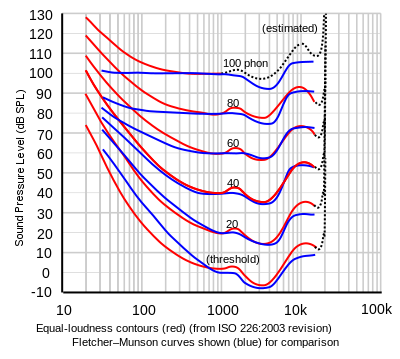
My intention here isn't to discourage people from building low distortion subs. Just pointing out that it's not going to sound like a conventional sub, and you'll want to invest quite a bit of effort to be sure that your cabinet walls aren't generating harmonic distortion on their own, and that the subwoofer is isolate from the room so that the force of the sub doesn't generate rattles among the items in your room. If you stuck one of these isobaric subs in the trunk of a car, there's a pretty good chance that the sound of the deck lid rattling would be quite a bit more audible than the subwoofer itself.
Attached is a comparison of the Cerwin Vega by itself (a 4ohm load) and isobaric, with the voice coils in parallel (a 2ohm load.) In the comparison, you can see the output level is basically identical. There's a variance of a fraction of one decibel. The iso pair has more output in the octave between 200 and 400Hz, I'm not entirely sure why that is.
The second and third attachments are a measurement of distortion. The 2nd attachment is conventional, the 3rd attachment is isobaric. Going isobaric doesn't eliminate distortion entirely, but it definitely reduces it:
- At 20Hz, 2nd harmonic distortion is reduced from 41.3% to 15%. That's a 63.7% reduction in 2nd harmonic.
- At 20Hz, 3rd harmonic distortion is reduced from 10.9% to 2.65%. That a 75.7% reduction in 3rd harmonic.
- At 30Hz, 2nd harmonic distortion is reduced from 11.6% to 7.2%. That's a 38% reduction in 2nd harmonic.
- At 30Hz, 3rd harmonic distortion is reduced from 1.8% to 1%. That a 44% reduction in 3rd harmonic.
- At 40Hz, 2nd harmonic distortion increased from 1.8% to 3.2%.
- At 40Hz, 3rd harmonic distortion increased from 0.4% to 0.8%
- At 60Hz, 2nd harmonic distortion is reduced from 5% to 1.25%. That's a 75% reduction in 2nd harmonic.
- At 60Hz, 3rd harmonic distortion increased from 0.5% to 1.0%.
- At 80Hz, 2nd harmonic distortion increased from 3.2% to 4%.
- At 80Hz, 3rd harmonic distortion is reduced from 0.6% to 1.8%.
It's nice being able to compare isobaric back-to-back with conventional mounting. It's noticeably cleaner.
Low distortion subs haven't been a big hit in the car audio world, IMHO. Companies like Pioneer, Alpine and Orion all offered them, ten years ago, but discontinued them. In the isobaric set up, I can kinda see why - once distortion is reduced sufficiently, you really don't "hear" the bass very much. Even with less than 100 watts on tap, the isobaric setup was able to cause things in my room to shake. IE, I could hear things being shaken by the force of the sub, but the bass itself wasn't particularly audible, especially below 60Hz:

My intention here isn't to discourage people from building low distortion subs. Just pointing out that it's not going to sound like a conventional sub, and you'll want to invest quite a bit of effort to be sure that your cabinet walls aren't generating harmonic distortion on their own, and that the subwoofer is isolate from the room so that the force of the sub doesn't generate rattles among the items in your room. If you stuck one of these isobaric subs in the trunk of a car, there's a pretty good chance that the sound of the deck lid rattling would be quite a bit more audible than the subwoofer itself.
Attachments
Attached are the Cerwin Vegas V 12s specs as published by Apex Jr back in the day, and also my measurement that I did today
My DATS always seems to wind up with a QTS figure that's quite a bit higher than published specs. Not sure if that's because this woofer came straight out of the box and hasn't been broken in at all, or due to age, or both.
My VAS measurement also looks to be on the high side, I was expecting something around 3-4 cubic feet.
If I wasn't so impatient, I'd burn these in for 24 hours and see if the QTS and VAS will go down
My DATS always seems to wind up with a QTS figure that's quite a bit higher than published specs. Not sure if that's because this woofer came straight out of the box and hasn't been broken in at all, or due to age, or both.
My VAS measurement also looks to be on the high side, I was expecting something around 3-4 cubic feet.
If I wasn't so impatient, I'd burn these in for 24 hours and see if the QTS and VAS will go down
Attachments
DATS measure impedance at low levels (not 1W)? Woofer is lying on the table/carpet or in vertical position like in loudspeaker box?
Thank you very much @Patrick Bateman for your study of the Isobaric Cone to Magnet study ! 😎 😎 😎
Your work matches the points announced by Vance Dickason (The Loudspeaker CookBook) and Martin Colloms (High Performance Loudspeakers) in their respective books. So it's both interesting and reassuring, since I am working on an Isobaric enclosure project :


T
Your work matches the points announced by Vance Dickason (The Loudspeaker CookBook) and Martin Colloms (High Performance Loudspeakers) in their respective books. So it's both interesting and reassuring, since I am working on an Isobaric enclosure project :
T
- once distortion is reduced sufficiently, you really don't "hear" the bass very much
This is what I try to explain to people. An excellent sub well integrated with the room and speakers doesn't sound like a subwoofer. It makes your main system sound like it has no limits to it's dynamic range, and often enough really cleans up imaging and spacial cueues. I've always attributed this to reduced tistortion above 80 Hz.
Stereophile was in the habit of discouraging audiophiles from buying subwoofers.
They also hated horns with a passion.
I know they came around on horns, and began to take them seriously about 20-25 years ago.
I have no idea what their current stance is on subs, but I distinctly remember them dismissing them for ages.
But they were a big fan of the "Muse Model 18" subwoofer: https://www.stereophile.com/content/muse-model-18-subwoofer-measurements

Their reviewers don't seem to be very technical, because it never occurred to them that maybe YOU NEED A BIG BOX AND A LOT OF POWER TO MAKE BASS.
The Model 18 was ahead of it's time; nowadays, subs like this are quite commonplace. But at the time, it was quite "far out" to use an eight cubic foot enclosure for dual 10s. According to the Stereophile review, the original version used dual eighteens(!), hence the name.
The author of the review seemed to attribute the excellent performance to the sixth order bandpass alignment, but I'd argue that it was simply the use of a big box and a lot of power (for the time.) IE, a couple of fifteens in a sealed box would likely perform as well.
I have a sub that's exactly like that. Bought it off Craigslist. Was made by some long forgotten audio company. I don't even recall the name. It's an eight cubic foot sealed box with dual fifteens and a 1000 watt plate amp from Parts Express.
Come to think of it...
There might be something to that bandpass alignment. Because I used to run a sub with dual TC Sounds fifteens in a 4th Order Bandpass Box, and that "disappeared" a little bit better. I ended up trashing it because it was huuuuuuuuge. Around twelve cubic feet.
They also hated horns with a passion.
I know they came around on horns, and began to take them seriously about 20-25 years ago.
I have no idea what their current stance is on subs, but I distinctly remember them dismissing them for ages.
But they were a big fan of the "Muse Model 18" subwoofer: https://www.stereophile.com/content/muse-model-18-subwoofer-measurements
Their reviewers don't seem to be very technical, because it never occurred to them that maybe YOU NEED A BIG BOX AND A LOT OF POWER TO MAKE BASS.
The Model 18 was ahead of it's time; nowadays, subs like this are quite commonplace. But at the time, it was quite "far out" to use an eight cubic foot enclosure for dual 10s. According to the Stereophile review, the original version used dual eighteens(!), hence the name.
The author of the review seemed to attribute the excellent performance to the sixth order bandpass alignment, but I'd argue that it was simply the use of a big box and a lot of power (for the time.) IE, a couple of fifteens in a sealed box would likely perform as well.
I have a sub that's exactly like that. Bought it off Craigslist. Was made by some long forgotten audio company. I don't even recall the name. It's an eight cubic foot sealed box with dual fifteens and a 1000 watt plate amp from Parts Express.
Come to think of it...
There might be something to that bandpass alignment. Because I used to run a sub with dual TC Sounds fifteens in a 4th Order Bandpass Box, and that "disappeared" a little bit better. I ended up trashing it because it was huuuuuuuuge. Around twelve cubic feet.
My pair of TC Sounds LMS-R 15” is each in an (undersized)2 cu ft sealed box, but with a Linkwitz Transform to flatten/extend the response. 4 cubes sealed would be better…
Integrating a subwoofer into a system can be a challenge. At least to the typical Stereophile reader/audiophile consumer. Certainly the advent of “room correction” products have made it easier, but setting up an room for listening to music, or a room for recording studio, or a room for mastering is part art, part science.
I recall an era where many sub-satellite systems had holes in their frequency response. In practical terms, having to to play with crossover point knobs, phase knobs and slope switches on the subwoofer. Or the recommendation to place a subwoofer at the primary listening position and crawling around of the ground near the screen to listen for the best bass response. By the principle of reciprocity, this certainly works, but I’m not sure how many people would do that.
Of course, other more hardcore enthusiasts eg. who came from the car audio world and had been measuring and equalising, brought their RTAs, or 31 band graphic equalisers to fine tune them.
I think M&K may have been the first company to establish a reputation that subwoofers were an legitimate solution in the home theatre space. Across the Atlantic perhaps it was REL. I don’t know, perhaps that’s was part marketing; perhaps it Bose or Sony… who probably outsold everyone with their home-theatre in a box systems. I’m sorry my hi-fi history is very American/English-centric and post 1980…
Anyway, I think it’s now accepted that subwoofers are a good thing(tm).
But it still sometimes feel like integrating a subwoofer is like asking a consumers to be their own crossover designers. So it’s always been a challenge.
Since 2015, SONOS, allowed for in-room measurements with their implementation of a moving-mic method; has certainly made it easier for the lay consumer to integrate their subwoofers and position/equalise their speakers. If a “high-end” brand like xxx implemented it, Stereophile would probably review, it and it would gain traction.
I remember when you needed a real silver disc player. And with the iPod that turned things upside down. So then DACs had a market place, and now streamers.
Meanwhile, some tinkerers have been using computers as ways to create, share, and listen to music since, well, before MIDI (1983)… let alone MPEG-1, Layer 3 (1991)
Integrating a subwoofer into a system can be a challenge. At least to the typical Stereophile reader/audiophile consumer. Certainly the advent of “room correction” products have made it easier, but setting up an room for listening to music, or a room for recording studio, or a room for mastering is part art, part science.
I recall an era where many sub-satellite systems had holes in their frequency response. In practical terms, having to to play with crossover point knobs, phase knobs and slope switches on the subwoofer. Or the recommendation to place a subwoofer at the primary listening position and crawling around of the ground near the screen to listen for the best bass response. By the principle of reciprocity, this certainly works, but I’m not sure how many people would do that.
Of course, other more hardcore enthusiasts eg. who came from the car audio world and had been measuring and equalising, brought their RTAs, or 31 band graphic equalisers to fine tune them.
I think M&K may have been the first company to establish a reputation that subwoofers were an legitimate solution in the home theatre space. Across the Atlantic perhaps it was REL. I don’t know, perhaps that’s was part marketing; perhaps it Bose or Sony… who probably outsold everyone with their home-theatre in a box systems. I’m sorry my hi-fi history is very American/English-centric and post 1980…
Anyway, I think it’s now accepted that subwoofers are a good thing(tm).
But it still sometimes feel like integrating a subwoofer is like asking a consumers to be their own crossover designers. So it’s always been a challenge.
Since 2015, SONOS, allowed for in-room measurements with their implementation of a moving-mic method; has certainly made it easier for the lay consumer to integrate their subwoofers and position/equalise their speakers. If a “high-end” brand like xxx implemented it, Stereophile would probably review, it and it would gain traction.
I remember when you needed a real silver disc player. And with the iPod that turned things upside down. So then DACs had a market place, and now streamers.
Meanwhile, some tinkerers have been using computers as ways to create, share, and listen to music since, well, before MIDI (1983)… let alone MPEG-1, Layer 3 (1991)
Last edited:
- Home
- Loudspeakers
- Multi-Way
- Some driver distortion measurements
